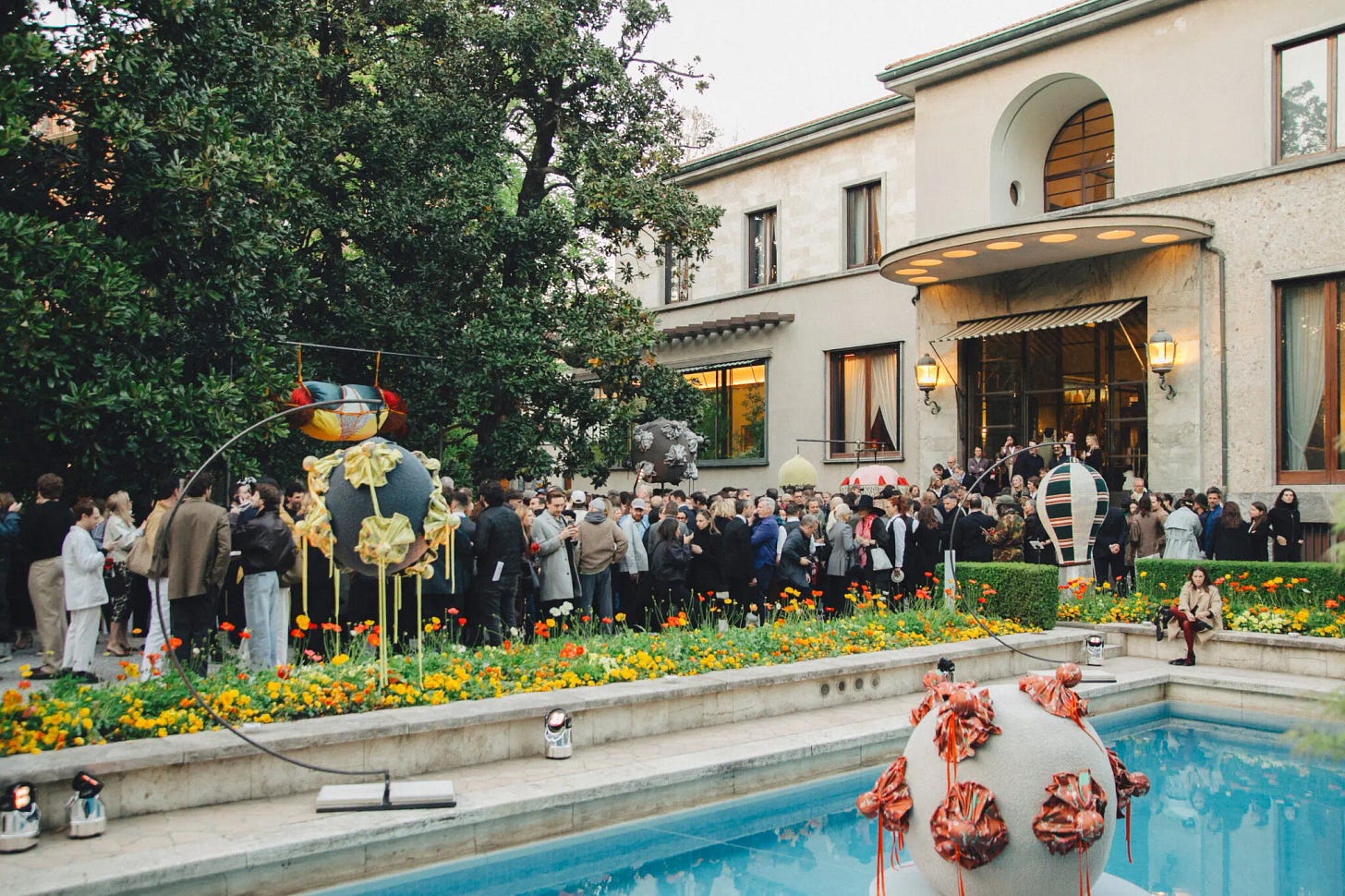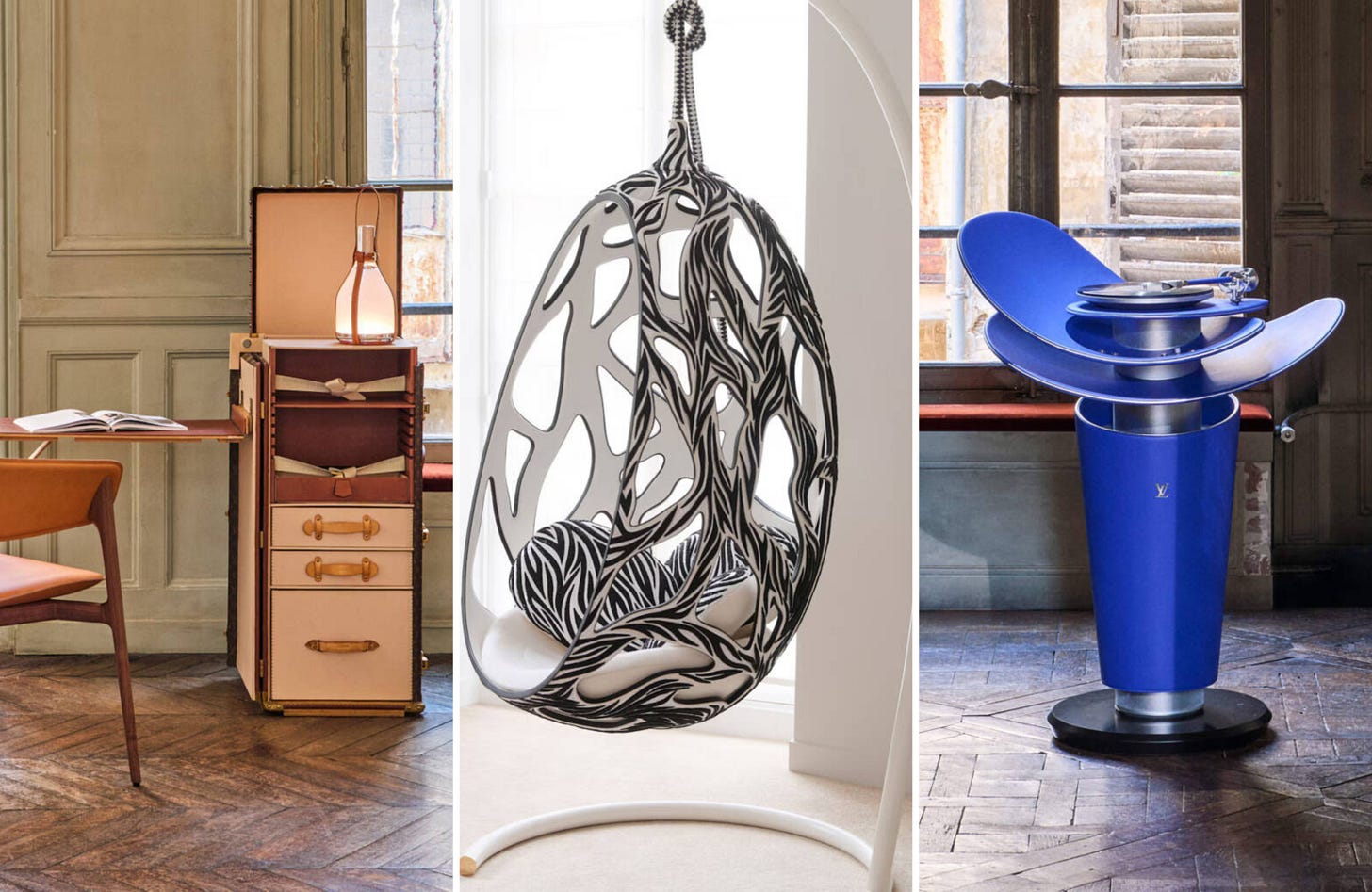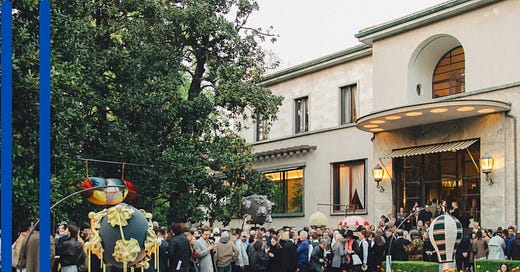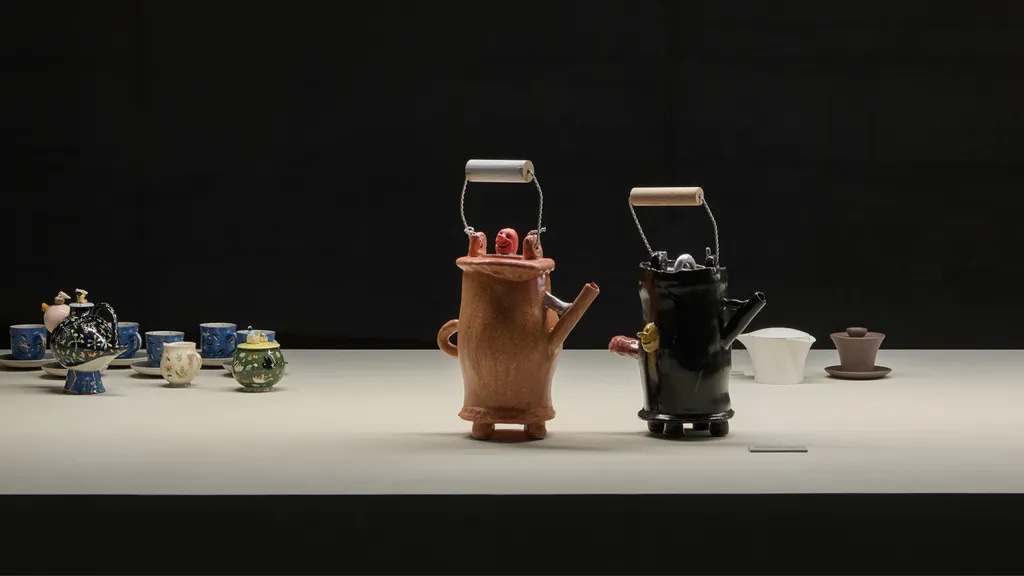Let's pretend we are at Milan Design Week.
Plus the legacy of the oldest American modern dance company.
Milan Design Week is in full swing, and while I strive to stay grounded in the present, I can't help but wish I were there to capture it all for the newsletter. Here's to manifesting attending in 2026.
This is where design truly comes alive—not just as a commercial showcase but as a cultural moment in time. As the lines between art, fashion, and interior design continue to blur, Milan Design Week becomes the epicenter of not just new products but cultural conversations. It continues to evolve into a space where luxury isn't just about high-end materials and exclusivity but about challenging the very nature of how we live.
With the theme Thought for Humans, this year’s Salone del Mobile (its 63rd edition) presents a forward-thinking exploration of design that balances innovation with sustainability and human-centric functionality. Spanning 169,000 square meters, the fair hosts over 2,100 exhibitors from 37 countries, featuring 168 new brands and 91 returning ones. The theme speaks to the growing demand for designs that respect and respond to human needs and behaviors.
With the debut of the Euroluce International Lighting Forum, set to explore lighting’s intersection with environmental impact, the conversations shaping the future of design are more critical than ever.
The New York Times Style Magazine returned to Milan with its annual Salone del Mobile fête, held once again within the refined gardens of Villa Necchi Campiglio — a 1930s architectural gem that now serves as one of the city’s most elegant museums. Each year, the publication invites a different artist or designer to transform the space with a site-specific installation, and this time, it was American sculptor and designer Misha Kahn who took up the brief.
Kahn, known for his irreverent, free-form approach to materials and shape, presented a whimsical assemblage of oversized inflatable sculptures draped in vibrant patchwork fabrics provided by Milanese textile house Dedar. The forms — somewhere between fantastical lampshades, lightbulbs, and abstract chandeliers — brought a dose of playful surrealism to the villa’s manicured grounds. Bold, buoyant, and disarmingly joyful, the installation offered a lighthearted counterpoint to the week's more serious design fare — a welcome reminder that good design can be both provocative and delightfully unserious.

Increasingly, Milan Design Week attracts luxury fashion houses whose homeware and furniture collections add an additional layer of glamour to the proceedings.
Gucci’s Bamboo Encounters exhibition provides a considered reflection on the brand’s craftsmanship, tracing one of its most enduring design codes back to its origins. First introduced in 1947 as a practical yet elegant solution for handbag handles, bamboo has since become synonymous with the house’s heritage. Staged at the 16th-century monastery Chiostri di San Simpliciano, this latest showcase bridges past and present, reaffirming Gucci’s ability to elevate tradition through a contemporary lens.
The Row made an elegant foray into interiors with its inaugural homeware collection, a study in restraint and refinement. Comprising sumptuous throws and bedding in the brand’s trademark neutral palette, each piece is handcrafted from exceptionally fine cashmere and wool. True to form, the collection speaks in hushed tones—luxury here is tactile, not loud—offering a serene extension of The Row’s minimalist design language into the domestic realm.
Louis Vuitton unveiled its new Home Collections at the grand Palazzo Serbelloni, expanding the maison’s vision of refined living. The line includes furniture, lighting, tableware, textiles—and, in a playful twist, games, including a pinball machine reportedly inspired by Pharrell Williams. Building on the success of Objets Nomades, the new offering pairs everyday function with elevated form. Visitors to Palazzo Serbelloni can view the collections side by side—an elegant dialogue between the experimental and the essential.

Hermès presented a bold, forward-facing home collection that departed from its usual heritage aesthetic. Creative directors Charlotte Macaux Perelman and Alexis Fabry traded in natural textures for surreal scenography, presenting colourful, Modernist-inspired pieces in suspended white alcoves. Translucent tables, Mondrian-esque throws, and geometric porcelain recall Bauhaus and Art Deco movements—proof that even tradition-steeped maisons like Hermès are ready to reimagine the future of the home.
This year, Prada’s annual symposium, Prada Frames, explored the theme “In Transit,” examining the infrastructure that facilitates the movement of both people and ideas. The discussions unfolded in two striking settings: the newly restored Arlecchino train, a 1950s icon designed by Gio Ponti and Giulio Minoletti, and Padiglione Reale, an opulent waiting room at Milan’s Central Station once reserved for royalty and heads of state. These spaces—rich in history and design—provided a fitting backdrop for a dialogue on connectivity and transition.
For its ninth craft exhibition, Loewe unveiled ‘Loewe Teapots,’ a striking collection of 25 reimagined teapots by international artists. From the coral-like glaze of South Korean artist Jane Yang-D'Haene’s creation to the surreal, dual-faced design by Spanish ceramicist Laia Arqueros Claramunt, the collection spans the spectrum from traditional ceramics to bold, avant-garde interpretations. Each piece invites a deeper reflection on the teapot’s place in daily rituals, elevating the humble vessel to an art form. If you, like me, drink copious amounts of tea, you'll know that the teapot is nothing short of sacred.
Nilufar Gallery collaborated with Fosbury Architecture on “Silver Lining,” a retrofuturist exhibition celebrating the expressive potential of metal—particularly aluminum. Set within a mirrored, labyrinthine installation, the show pairs 1970s masterworks by Gabriella Crespi and Mario Bellini with contemporary pieces by the likes of Supaform and Odd Matter. The result was a sleek, immersive space where eras blur and chrome surfaces reflect a shared design language—one that finds poetry in resilience and elegance in structure.
Aesop’s The Second Skin, an immersive installation at the historic Chiesa del Carmine, reimagines skin as both a physical and symbolic boundary through scent, touch, and design. A communal hand-washing ritual and a 16-metre table by Sebastian Cox anchor the sensory experience, while the adjacent Capsule of Respite offers a tranquil retreat with vintage Italian furniture and soothing hand massages. As Sensory Patron of Milan Design Week, Aesop shows that true luxury lies in multisensory engagement—a future where design is felt as much as it is seen.
And, of course, Miu Miu’s literary club—blurring the lines between culture and commerce. Now in its second edition, it returns as the thinking woman’s antidote to visual overload. Set within the Circolo Filologico, Milan’s oldest cultural club, the two-day salon-style event revives the spirit of old-world literary circles—with a thoroughly modern twist. This year’s theme, A Women’s Education, draws on Simone de Beauvoir’s The Inseparables and Fumiko Enchi’s The Waiting Years to unpack girlhood, desire, and the shaping of feminist consciousness. With a panel lineup that includes Lauren Elkin, Geetanjali Shree, Naoise Dolan, and Sarah Manguso, it’s a stylishly cerebral affair that proves once again: at Miu Miu, the book is just as covetable as the bag.
Santoni’s debut on Via Monte Napoleone, Jil Sander’s new fragrance collection, and the introduction of homewares from British jewelry brand Completedworks all underscore Milan’s status as more than just a luxury hub—it’s where beauty, craftsmanship, and thoughtful design converge.
Design, after all, is about more than just objects; it’s about shaping the world we want to inhabit. As brands, artists, and designers push boundaries, Milan’s role as the global design capital grows ever more secure. Each year further solidifies this narrative—if this edition is any indication, Milan’s reign is not only intact but thriving.
In today’s edition: a refugee camp reimagined as a self-sustaining city, Japan’s innovative 3D-printed train station, Etsy’s latest trend report, the rise of Trader Joe’s totes and my dream bags, plus the legacy of the oldest American modern dance company, still performing after all these years.
Kakuma, a remote Kenyan refugee camp, was never intended to be permanent, yet it has housed 300,000 refugees since 1992. In an ambitious shift, the Kenyan government and aid agencies are transforming Kakuma into a self-sustaining city, aiming to integrate refugees into the local economy. While the camp's redesignation as a municipality offers hope for self-reliance, challenges remain, particularly in terms of access to employment and financial services. Initiatives like Inkomoko’s low-interest loans have allowed some refugees to start businesses, but limited infrastructure and resources, such as water, pose significant hurdles. Critics question whether Kakuma can truly sustain an economy without addressing these foundational issues. Still, the move to reduce reliance on aid is a positive step, emphasizing economic independence. However, it must be paired with a commitment to refugee rights and mobility to ensure that the transformation does not become a mere exercise in social engineering, but a sustainable solution. (The largest refugee camp in the world is the Kutupalong refugee camp in Cox’s Bazar, Bangladesh, which hosts a population of 800,000 Rohingya refugees who fled violence in Myanmar’s Rakhine State.)
Zimbabwe has issued over $300 million in bonds as part of efforts to compensate farmers whose land was seized during the controversial land reform program 25 years ago. The program, which ignited violent evictions in 2000 and led to a series of Western sanctions, remains a contentious chapter in the country’s history. While the bonds represent a step toward reconciliation, questions linger about the effectiveness of these measures in addressing the broader economic and political repercussions of the land crisis.
Weeks after a wave of retaliatory violence claimed over 1,000 lives in Syria's Alawite heartland, the coastal provinces of Latakia and Tartous remain in shock, grappling with the brutality of the killings. Following the ousting of Bashar al-Assad's regime, a fresh wave of sectarian violence erupted after an ambush by Assad loyalists, leading to massacres in Alawite villages. Survivors, many of whom had supported the new government, are left questioning its ability to uphold promises of peace. The government has vowed to bring justice, but eyewitnesses report that perpetrators remain unpunished, stoking fears of an escalating cycle of violence. Amid growing mistrust, Alawite residents, once hopeful for change, now question whether Syria’s new rulers can heal deep-rooted divisions or if they will perpetuate the same injustices.
In rural Japan, where population decline is reshaping infrastructure, a pioneering 3D-printed train station was built in a mere six hours, replacing a 75-year-old wooden structure. This world-first project by West Japan Railway and construction firm Serendix saw pre-printed parts, reinforced with concrete, transported overnight and assembled on-site, with the station completed before dawn. Located in Hatsushima, a small seaside town in Wakayama Prefecture, the new station is a minimalist structure inspired by local icons, designed to maintain rail service with fewer workers. As Japan’s workforce shrinks, 3D printing offers an innovative solution to sustain transportation in remote areas, reducing both construction time and costs. However, while this experiment proves the potential of new technologies, it also raises questions about the future of traditional craftsmanship in an age of automation. In a country known for its meticulous attention to detail and craftsmanship, the speed of this modern solution is impressive, yet its impact on local culture and employment warrants closer consideration. The new station, though a success, is a reminder that technological advancement must be carefully balanced with preserving the human touch that has long defined Japan’s engineering marvels.
On Chicago's South Side, a $9 billion quantum computing campus is set to rise on the site of the former US Steel mill. Backed by major tech players like PsiQuantum and IBM, the project aims to position Chicago as a leader in the quantum tech sector, with promises of thousands of jobs and innovation. The campus will feature a 300,000-square-foot facility for PsiQuantum, focused on building the world’s first commercially viable quantum computer. However, the development has sparked concerns among local residents, who fear displacement and environmental risks. The area, long affected by industrial pollution, has seen numerous failed redevelopment plans in the past. Community groups are calling for a community benefits agreement (CBA) to ensure local jobs, affordable housing, and educational opportunities. Developers have pledged to address environmental issues and provide job training, but the lack of a formal CBA remains a contentious issue as the project moves forward.
U.S. Navy Vice Admiral Shoshana Chatfield was dismissed by Secretary of Defense Pete Hegseth, continuing the trend of sidelining women and people of color from senior military roles under the Trump administration. Chatfield, the only woman on NATO’s military committee, was a prominent figure in defense circles, yet her removal comes amid broader rhetoric from Hegseth, who has expressed opposition to women serving in combat positions.
Etsy is doubling down on its trendsetting cred with a sleek new AI-powered discovery experience and its second annual spring/summer trend report—both designed to spotlight the originality of its maker community and the whims of its ever-curious shoppers. The app’s refreshed interface now offers curated collections driven by machine learning and human taste, all organized by vibe: think Châteaucore, Island Luxe, Messy Coquette, and the Literary Girl (BookTok, but chicer). Apparently, Etsy has seen 20,000 book-related purchases daily from book accessories like hats to 'bookish' jewelry. Fascinating. According to Etsy trend expert Dayna Isom Johnson, this season is all about “midimalism”—where statement meets simplicity. To me, this is just normal style, but I do think we are seeing a shift away from minimalism to something a bit more exciting.
A $2.99 canvas tote from Trader Joe’s caused a frenzy in San Francisco, with more than 300 people queuing and the bags selling out in just 40 minutes. The reason? It's now popping up on eBay for nearly $1,000. Apparently, nothing says status symbol quite like grocery chic.
While we are on the topic of bags, Métier makes the most perfect ones.
The Martha Graham Dance Company returns to New York’s cherished Joyce Theater—an intimate Chelsea stage renowned for spotlighting cutting-edge movement—for its 99th-anniversary season with Dances of the Mind, a compelling mix of legacy and innovation. As the oldest American modern dance company, it remains rooted in the radical vision of its founder, Martha Graham (1894–1991), who choreographed 181 works (!) and developed a technique as foundational to modern dance as ballet is to the classical tradition. Evolved from the rhythms of breath, Graham's technique—once dubbed the cornerstone of American modern dance—is still taught worldwide and fuels both the revival of her masterpieces and the creation of bold new work. Graham’s singular technique and fearless heroines continue to command the stage.







